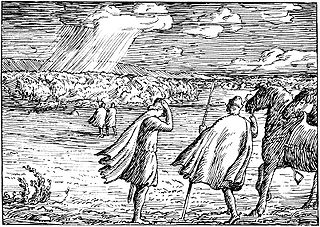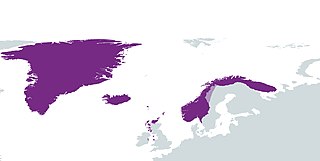Related Research Articles

Harald Sigurdsson, also known as Harald III of Norway and given the epithet Hardrada in the sagas, was King of Norway from 1046 to 1066. Additionally, he unsuccessfully claimed both the Danish throne until 1064 and the English throne in 1066. Before becoming king, Harald had spent around fifteen years in exile as a mercenary and military commander in Kievan Rus' and as a chief of the Varangian Guard in the Byzantine Empire.

Magnus Olafsson, better known as Magnus the Good, was King of Norway from 1035 and King of Denmark from 1042 until his death in 1047.

Olaf II Haraldsson, later known as Saint Olaf, was King of Norway from 1015 to 1028. Son of Harald Grenske, a petty king in Vestfold, Norway, he was posthumously given the title Rex Perpetuus Norvegiae and canonised at Nidaros (Trondheim) by Bishop Grimkell, one year after his death in the Battle of Stiklestad on 29 July 1030. His remains were enshrined in Nidaros Cathedral, built over his burial site. His sainthood encouraged the widespread adoption of Christianity by Scandinavia's Vikings/Norsemen.

Olaf III or Olaf Haraldsson, known as Olaf the Peaceful, was King of Norway from 1067 until his death in 1093.
Magnus Haraldsson was King of Norway from 1066 to 1069, jointly with his brother Olaf Kyrre from 1067. He was not included in official Norwegian regnal lists until modern times, but has since been counted as Magnus II.
Olaf Haraldsson may refer to:

The Battle of Stiklestad in 1030 is one of the most famous battles in the history of Norway. In this battle, King Olaf II of Norway was killed. During the pontificate of Pope Alexander III, the Roman Catholic Church declared Olaf a saint in 1164.

The Fairhair dynasty was a family of kings founded by Harald I of Norway which united and ruled Norway with few interruptions from the latter half of the 9th century. In the traditional view, this lasted until 1387, however, many modern scholars view this rule as lasting only three generations, ending with Harald Greycloak in the late 10th century. The moniker "Fairhair dynasty" is a retrospective construction: in their lifetime what little traces there are refer to them consistently as "Ynglings".

Einar Eindridesson Thambarskelfir was an influential Norwegian noble and politician during the 11th century. He headed the feudal lords in their opposition to Olaf Haraldsson.

Rex Perpetuus Norvegiæ is a term for King Olaf II of Norway, also known as Saint Olaf.
Svein Knutsson was the son of Cnut the Great, king of Denmark, Norway, and England, and his first wife Ælfgifu of Northampton, a Mercian noblewoman. In 1017 Cnut married Emma of Normandy, but there is no evidence that Ælfgifu was repudiated, and in 1030 Cnut sent her and Svein as regents to rule Norway. However, their rule was considered oppressive by the Norwegians. They imposed new taxes and harsh laws that made them unpopular and they were expelled in 1034.
Olaf of Norway – Norwegian: Olav - may refer to:

Astrid Olofsdotter was the queen consort of King Olaf II of Norway.
The Hardrada dynasty was a powerful royal dynasty which ruled, at various times in history, the Kingdom of Norway, the Kingdom of Mann and the Isles, and the Earldom of Orkney.
Events in the year 1093 in Norway.
Events in the year 1069 in Norway.

Kálfr Árnason was an 11th-century Norwegian chieftain who played a major role both in defeating King Olaf Haraldsson at the Battle of Stiklestad and in bringing back his young son Magnus and raising him to the throne.
Bersöglisvísur is a skaldic poem composed by the Icelandic skald Sigvatr Þórðarson.

Hårek of Tjøtta was a Norwegian farmer and local chieftain. He was a son of the skald, Eyvindr skáldaspillir, who ruled from Tjøttagodset. Hårek resided at Tjøtta in Nordland, and had significant influence in the district of Hålogaland. He participated in the Battle of Stiklestad in 1030, where his peasant army defeated Olaf Haraldsson. Six years later when visiting king Magnus Olavsson I also known as Magnus the Good in Trondheim, he was killed by axe in 1036 by rival chieftain Åsmund Grankjellsson, and thus the former king's son got his revenge.

The term Norwegian Realm and Old Kingdom of Norway refer to the Kingdom of Norway's peak of power at the 13th century after a long period of civil war before 1240. The kingdom was a loosely unified nation including the territory of modern-day Norway, modern-day Swedish territory of Jämtland, Herjedalen, Ranrike (Bohuslän) and Idre and Särna, as well as Norway's overseas possessions which had been settled by Norwegian seafarers for centuries before being annexed or incorporated into the kingdom as 'tax territories'. To the North, Norway also bordered extensive tax territories on the mainland. Norway, whose expansionism starts from the very foundation of the Kingdom in 872, reached the peak of its power in the years between 1240 and 1319.
References
- ↑ "Olaf II Haraldsson | king of Norway".
- ↑ http://familytreemaker.genealogy.com/users/h/o/f/Jeanne-M-Hoflen/WEBSITE-0001/UHP-0975.html [ user-generated source ]
- ↑ Krag, Claus (28 September 2014). "Magnus 1 Olavsson Den Gode". In Helle, Knut (ed.). Norsk biografisk leksikon (in Norwegian). Oslo: Kunnskapsforlaget. Retrieved 22 July 2015.